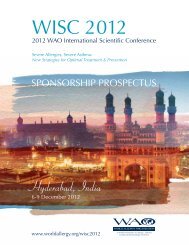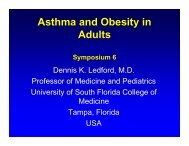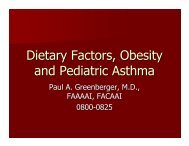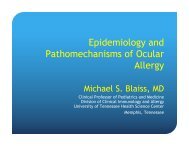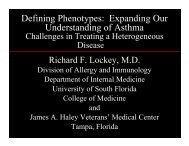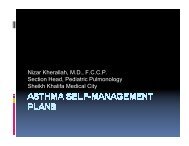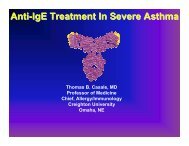Dubai Final-v20.indd - World Allergy Organization
Dubai Final-v20.indd - World Allergy Organization
Dubai Final-v20.indd - World Allergy Organization
You also want an ePaper? Increase the reach of your titles
YUMPU automatically turns print PDFs into web optimized ePapers that Google loves.
ABstrACts<br />
ABstrACts<br />
3319<br />
PUlmonarY FUnCTion TEST in HEalTHY CHilDrEn 7 To 9 YEarS aFTEr rESPiraTorY Viral inFECTionS<br />
Kartasasmita, iV, C. B. , sudarwati, s. , Wulandari, D. A. , suwardi, A. U. , saptaputra, W. , nuradi, i. , Kuswandewi, m. and simoes, E.<br />
A.<br />
Department of Child Health, Hasan sadikin/school of medicine Padjadjaran University, Bandung, indonesia, Bandung, indonesia.<br />
Background. Pulmonary function test (PFts) provides an assessment of airflow limitation. it can be used for diagnosis of asthma in<br />
children over 6 years of age. Viral infections during infancy can cause wheezing (roberg et al. 2007) and abnormal lung function<br />
at 6 years of age (Anderson et al. 2008). the aim of this study is to determine the PFts in children 7 to 9 years after viral respiratory<br />
infections.<br />
materials and methods. this study is a part of a nested case control study entitled “rsV and recurrent wheezing in indonesia:<br />
7 – 9 year follow-up study with lung function studies”. the PFts were obtained from December 2009 to July 2010. All the<br />
children were healthy when the PFts were performed. to determine the obstructive impairment we analyzed FEV1 and FEV1/<br />
FVC ratio. reversibility was measured in children with % predictive FEV1 < 80%, before and after administration of a short acting<br />
bronchodilator.the FEV1/FVC ratio > 80% showed normal lung function.<br />
results. A total 218 children, age 8.4 to 13.4 years old (mean 10.5 ± 1.05 years), consisted of 111 boys and 107 girls, were<br />
enrolled in the study. Fifty two cases with history of viral respiratory infections, and 166 controls. the viral pathogens found were:<br />
rsV (25), rV (19), mix rsV and rV (6), and hmPV (2). the mean ± sD of FEV1 in cases (2.12 ± 0.42) was slightly higher than<br />
control (2.04 ± 0.39), however, the difference was statisticaly not significant. the mean ± sD FEV1/FVC ratio in cases (90.76 ±<br />
9.15) and in control (92.28 ± 6.5) were also statisticaly no difference. in 14 out of 218 (6.4%) children the reversibility test were ><br />
12%.<br />
Conclusion: the PFts in children with history of viral respiratory infections are within normal limit, 7 to 9 years later. the rate of<br />
asthma is low.<br />
3320<br />
CliniCal ProFilE anD riSK FaCTorS in HoSPiTaliZED CHilDrEn WiTH BronCHioliTiS<br />
Kirovski, i. , nikolovski, l. , sazdovski, A. , micevska, V. and seckova, l.<br />
Department of Pulmonology and Allergology, University Children’s Hospital, skopje, macedonia.<br />
Bronchiolitis, potentially life-threatening respiratory condition is the most common reason for hospitalization in infancy.<br />
the aim of the study was to determine the risk factors and to describe the clinical profile in children who were admitted to the<br />
hospital with a diagnosis of bronchiolitis.<br />
methods: We studied 153 children, the analysis we conducted was restricted to first hospitalizations within the first 18 months. Data<br />
from their medical records were entered in a specially designed questionnaire. the following data were analyzed: age on admission,<br />
gender, gestational age, association of bronchiolitis with children’s nutritional status. Clinical factors such as chronic lung disease<br />
and congenital heart disease (CHD) were investigated. socioeconomic status, possible exposure to passive smoking, family history<br />
of atopy, number of siblings were also investigated. the respiratory rate, oxygen saturation, presence of chest wall retractions and<br />
cyanosis upon admission were noted.<br />
results: Of the 153 patients 85 were males and 68 females, giving a male to female ratio of 1,25:1. sixty-six percent were<br />
under 9 months of age and were previously healthy children. We could not find significant association between bronchiolitis and<br />
nutritional status. shorter or lack of exclusive breastfeeding was a risk factor for the hospitalization. 37% of the children were<br />
passive smokers. socioeconomic status was a factor in increasing the risk of hospital admission in our patients. Prevalence rate<br />
for bronchiolitis was higher in rural areas compared to urban ones. Other factors, such as a diagnosis of bronchodysplasia, CHD,<br />
and prematurity were not significantly associated with being hospitalized for bronchiolitis. the best method for initial assessment of<br />
bronchiolitis was oxygen saturation.<br />
Conclusion: the youngest infants and those who have been exposed to cigarette smoke after birth have the highest risk of<br />
bronchiolitis. the association between socioeconomic factors and hospitalization indicates that these factors may have a significant<br />
influence on the hospitalization rate in bronchiolitis during infancy. the promoting of exclusive breastfeed ing is for prevention of<br />
infectious diseases and also because of the lesser aggressive course of bronchiolitis in breastfed children.<br />
www.worldallergy.org 160<br />
FinAl PrOgrAm



